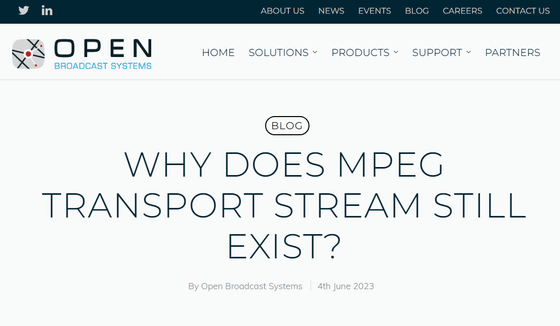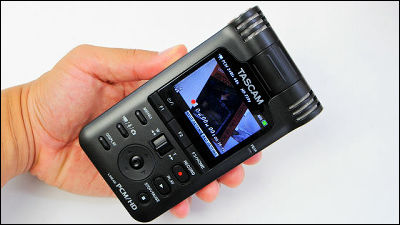Why does 'MPEG-2 TS' still exist, and what are its advantages and is it difficult to replace it?

The Moving Picture Experts Group (MPEG) , one of the international standards for compressing video and audio, has standards such as MPEG-1, MPEG-2, and MPEG-4. Of these, MPEG-2 is mainly used for TV broadcasting and DVD, and ' MPEG-2 TS ' is used as a container for digital TV broadcasting in particular. British company Open Broadcast Systems, which develops broadcast tools, explains why MPEG-2 TS, which has been in use for more than a quarter of a century since the establishment of the standard, is still used in the broadcasting industry.
Why does MPEG Transport Stream still exist? | Open Broadcast Systems
https://www.obe.tv/why-does-mpeg-ts-still-exist/

Open Broadcast Systems said, ``There is a tendency in the broadcasting industry to reminisce about the good old days, and it is easy to think that the reason for continuing to use MPEG-2 TS is one of those trends, but in fact, it is not only for historical reasons, There are also strong technical reasons,' he said.
◆Error tolerance
``TS'' in MPEG-2 TS is an abbreviation for ``Transport Stream,'' and is a transmission format originally intended to transfer signals from one point to another via IP networks, satellites, and cables. Basically, when transferring a video signal, some kind of packet loss or bit inversion always occurs. To minimize this packet loss and bit flipping, the transmission format must have a means of quickly recovering from errors.
In the case of television broadcasting, it is basically unacceptable for the image to stop or be interrupted for a few seconds. In the case of MPEG-2 TS, in addition to data transfer, the ' overhead ' of processing such as reception confirmation and retransmission is large, but error tolerance is high accordingly, and even if packet loss and bit inversion occur, You can recover quickly to a level that viewers will hardly notice if it happens.
On the other hand, TCP -based protocols such as RTMP are not prepared for packet loss or bit flipping, and basically wait until packet loss occurs until recovery, which is prone to delays.

◆ Video clock synchronization
In television broadcasting, the source video is encoded on the transmitting side and transferred, and the data is passed through a decoder on the receiving side to be played back. video cannot be played on the receiving end.
MPEG-2 TS introduces a mechanism called `` program clock reference (PCR) '' that synchronizes the clock on the receiving side with the sending side by transferring clock correction data from the sending side together. It is thanks to this PCR that even images taken in places where it is not possible to communicate with NTP or GPS satellites can be distributed. Open Broadcast Systems says, 'Other than MPEG-2 TS, no other format has a clock reproduction scheme with the accuracy required by the broadcast industry.'

◆ Synchronization of video and audio
WebRTC and ST-2110 separate Real-time Transport Protocol (RTP) flows for video and audio. However, since the video clock is generally 90KHz and the audio clock is 48KHz, processing the video and audio separately on the receiver side may result in a sound lag. To prevent this sound lag, WebRTC uses NTP and ST-2110 uses Precision Time Protocol (PTP) to periodically synchronize video and audio.
However, since MPEG-2 TS transfers video, audio, text, etc. together in one 'program', there is no need to worry about sound lag in the first place.

◆Definition of latency
MPEG-2 TS has to output data at the maximum rate, unlike a web stream that exceeds the maximum bitrate in an instant, so there is latency before the receiver's decoder starts playing. MPEG-2 TS is the only container that allows well-defined decoder latency, allowing users to optimize the trade-off between latency and compression efficiency according to their application. Being able to define this latency allows us to synchronize the timing of all the footage when playing multiple camera angles on the decoder side.
In addition, it is necessary to support 'multicast' so that multiple listeners can receive it at the same time, it is necessary to transmit subtitles for teletext broadcasting and digital video broadcasting , and it is necessary to support interlaced video. There are various requirements for broadcast containers. Open Broadcast System explained that MPEG-2 TS has been used for a long time in the broadcasting industry because only MPEG-2 TS can transmit high-quality video while satisfying all these requirements. .
Related Posts:
in Note, Posted by log1i_yk







